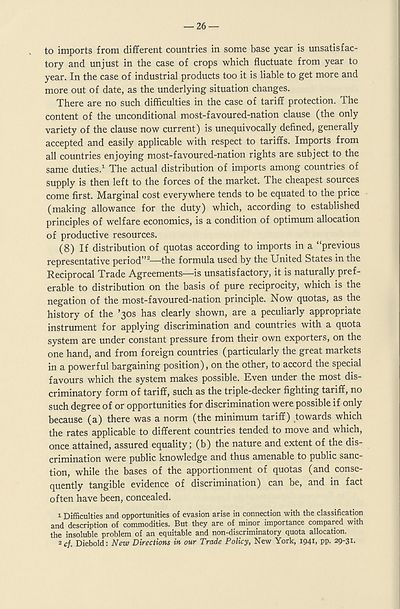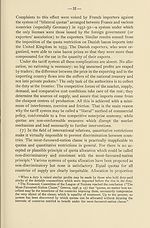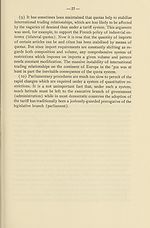Download files
Complete book:
Individual page:
Thumbnail gallery: Grid view | List view

— 26 —
to imports from different countries in some base year is unsatisfac¬
tory and unjust in the case of crops which fluctuate from year to
year. In the case of industrial products too it is liable to get more and
more out of date, as the underlying situation changes.
There are no such difficulties in the case of tariff protection. The
content of the unconditional most-favoured-nation clause (the only
variety of the clause now current) is unequivocally defined, generally
accepted and easily applicable with respect to tariffs. Imports from
all countries enjoying most-favoured-nation rights are subject to the
same duties.1 The actual distribution of imports among countries of
supply is then left to the forces of the market. The cheapest sources
come first. Marginal cost everywhere tends to be equated to the price
(making allowance for the duty) which, according to established
principles of welfare economics, is a condition of optimum allocation
of productive resources.
(8) If distribution of quotas according to imports in a “previous
representative period”2—the formula used by the United States in the
Reciprocal Trade Agreements—is unsatisfactory, it is naturally pref¬
erable to distribution on the basis of pure reciprocity, which is the
negation of the most-favoured-nation principle. Now quotas, as the
history of the ’30s has clearly shown, are a peculiarly appropriate
instrument for applying discrimination and countries with a quota
system are under constant pressure from their own exporters, on the
one hand, and from foreign countries (particularly the great markets
in a powerful bargaining position), on the other, to accord the special
favours which the system makes possible. Even under the most dis¬
criminatory form of tariff, such as the triple-decker fighting tariff, no
such degree of or opportunities for discrimination were possible if only
because (a) there was a norm (the minimum tariff) towards which
the rates applicable to different countries tended to move and which,
once attained, assured equality; (b) the nature and extent of the dis¬
crimination were public knowledge and thus amenable to public sanc¬
tion, while the bases of the apportionment of quotas (and conse¬
quently tangible evidence of discrimination) can be, and in fact
often have been, concealed.
1 Difficulties and opportunities of evasion arise in connection with the classification
and description of commodities. But they are of minor importance compared with
the insoluble problem of an equitable and non-discriminatory quota allocation.
2 cf. Diebold: New Directions in our Trade Policy, New York, 1941, pp. 29-31.
to imports from different countries in some base year is unsatisfac¬
tory and unjust in the case of crops which fluctuate from year to
year. In the case of industrial products too it is liable to get more and
more out of date, as the underlying situation changes.
There are no such difficulties in the case of tariff protection. The
content of the unconditional most-favoured-nation clause (the only
variety of the clause now current) is unequivocally defined, generally
accepted and easily applicable with respect to tariffs. Imports from
all countries enjoying most-favoured-nation rights are subject to the
same duties.1 The actual distribution of imports among countries of
supply is then left to the forces of the market. The cheapest sources
come first. Marginal cost everywhere tends to be equated to the price
(making allowance for the duty) which, according to established
principles of welfare economics, is a condition of optimum allocation
of productive resources.
(8) If distribution of quotas according to imports in a “previous
representative period”2—the formula used by the United States in the
Reciprocal Trade Agreements—is unsatisfactory, it is naturally pref¬
erable to distribution on the basis of pure reciprocity, which is the
negation of the most-favoured-nation principle. Now quotas, as the
history of the ’30s has clearly shown, are a peculiarly appropriate
instrument for applying discrimination and countries with a quota
system are under constant pressure from their own exporters, on the
one hand, and from foreign countries (particularly the great markets
in a powerful bargaining position), on the other, to accord the special
favours which the system makes possible. Even under the most dis¬
criminatory form of tariff, such as the triple-decker fighting tariff, no
such degree of or opportunities for discrimination were possible if only
because (a) there was a norm (the minimum tariff) towards which
the rates applicable to different countries tended to move and which,
once attained, assured equality; (b) the nature and extent of the dis¬
crimination were public knowledge and thus amenable to public sanc¬
tion, while the bases of the apportionment of quotas (and conse¬
quently tangible evidence of discrimination) can be, and in fact
often have been, concealed.
1 Difficulties and opportunities of evasion arise in connection with the classification
and description of commodities. But they are of minor importance compared with
the insoluble problem of an equitable and non-discriminatory quota allocation.
2 cf. Diebold: New Directions in our Trade Policy, New York, 1941, pp. 29-31.
Set display mode to:
![]() Universal Viewer |
Universal Viewer | ![]() Mirador |
Large image | Transcription
Mirador |
Large image | Transcription
Images and transcriptions on this page, including medium image downloads, may be used under the Creative Commons Attribution 4.0 International Licence unless otherwise stated. ![]()
| League of Nations > Economic and financial section > Quantitative trade controls > (28) |
|---|
| Permanent URL | https://digital.nls.uk/190588357 |
|---|
| Shelfmark | LN.II |
|---|
| Description | Over 1,200 documents from the non-political organs of the League of Nations that dealt with health, disarmament, economic and financial matters for the duration of the League (1919-1945). Also online are statistical bulletins, essential facts, and an overview of the League by the first Secretary General, Sir Eric Drummond. These items are part of the Official Publications collection at the National Library of Scotland. |
|---|---|
| Additional NLS resources: |
|

